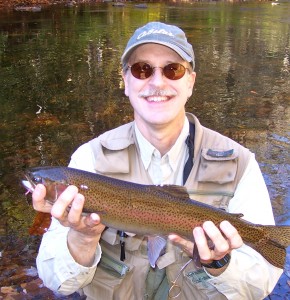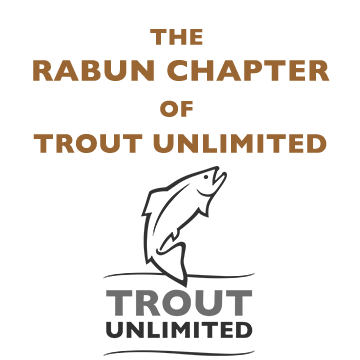 By Jeff Durniak, Georgia Wildlife Resources Division
By Jeff Durniak, Georgia Wildlife Resources Division
What’s a “good day?” The definition of “a good day” may be three trout for a rookie, but it may be 20 fish including 3 whoppers for some of your veterans. To each, his own. We each have our own definition of a “good day fishing” and each person’s opinion is equally valid. For me, fishing is not competitive. It’s not how many I catch, it’s about fishing with friends in scenic locales and hopefully catching some fish, maybe even a big one if we’re lucky and have prepared well. And yesterday, it was not even wetting my line, but simply putting a friend in the right spot and watching the smiles on Mark’s face as the rod bent. Indeed, my day was good!
Many of you on this email list are undoubtedly more gifted fly anglers than me. This note is simply aimed at the new folks among us who may benefit from some winter trouting tips. I met several of you streamside or in sporting goods stores this week. For the new folks, may I offer this winter recipe to help you through a fun but challenging season for Georgia trout, hopefully without breaking your dwindled, post-holiday bank account. There is not one “right way” of fishing. However, this way has worked for me and maybe it will work for you, too. And don’t worry, it gets a lot easier in the spring, when the water warms and the fish will chase your offering. Here we go:
Obtain at least 3 of each of these flies: #10 black woolly bugger #14 peach egg fly # 14 prince nymph
# 16 hare’s ear nymph #18 pheasant tail nymph #18 pheasant tail- soft hackle wet fly (No beads on the flies.)
Get a few 7.5 foot 3 X trout leaders and two spools of tippet (5x and 6X). Get 2 or 3 sizes of split shot: 1) the tiny shot, like Dinsmores, 2) size B, 3) size BB. Buy a few strike indicators.
Arrive at stream at 10 AM and fish til 3 or 4. Tie 18 inches of 5X to your leader’s 3X end. Add enuf shot above that knot to let your fly tick-tick along the stream bottom. That may mean one tiny shot or 4 big ones, depending on the water depth and speed of each pool or run. Tie the bugger, egg, or prince to the 5X tippet end. Put your strike indicator way up your leader, toward your fly line. The length between the indicator and your fly should be at least 1.5 if not 2X or more the water depth of the spot you’re fishing. Adjust as needed for each pool or run.
Toss this combo upstream at a 30 degree angle 3-6 feet above where you think the fish are holding and let it drift, drag-free, back down toward you. If you bump the fly along the bottom in a spot where fish are (slower areas during winter), you may get some hits. The strike indicator will show you those bottom
ticks and the strikes. With the bugger, after your fly drifts downstream, well past you, twitch your rod tip and strip the fly back upstream in 6 inch strips.
Now here’s the secret weapon. Many of our trout in these catch&release waters have, indeed, been caught and released. They smarten up and avoid big flies and beads, unless the water’s muddy. Smithgall is the most extreme example of all! You’ll have better success if you tie on 12-18 inches of 6X to the bend of the hook of the first fly and then tie on one of the small flies on the list, above. Start out “big” (size 14 or 16) and, if you don’t get strikes, substitute the smaller flies. Sometimes I’ll even go down to a #20 pheasant tail or soft hackle, but it’s hard to hook fish with such tiny hooks. Roll cast or water load. Try not to false cast or do it minimally, as the fish are not in the air or trees, the branches and tangles are.
As a resource manager and fellow angler, each year at this time I often hear anglers’ comments about their reduced catch rates. Their stated reasons often include “lack of stocking” and “poachers.” Based on my experience, the reasons are more often:1) released fish “smartened up” from their earlier experiences with you, 2) lethargic fish due to cold water, and 3) the angler’s fly or lure not being down where the fish are, since those fish are not gonna come get it like they did in November, when the water was warmer and they were naive.
The “tiny fly off the back” technique works for me in these clear waters where the fish are now experienced and cold. Maybe it will work for you, too, if the water’s 40F or warmer. If it does, you’ll notice that you’ll catch some more colorful and harder fighting fish- the earliest stocked veterans or even the wild fish. The fresh stockers will still slam your gaudy bead fly, egg or Y2K.
Good luck!
www.gofishgeorgia.com
